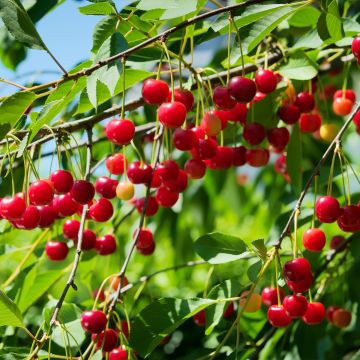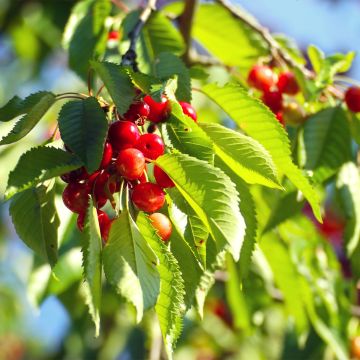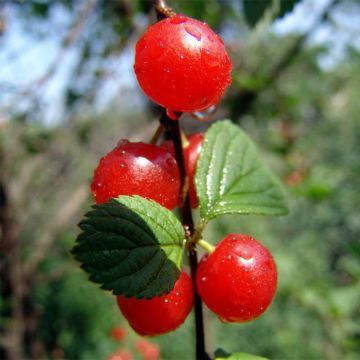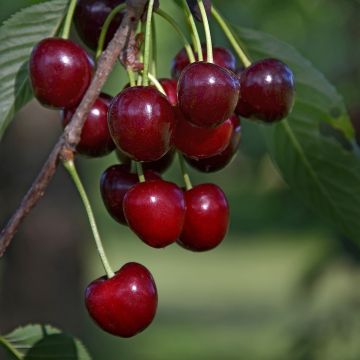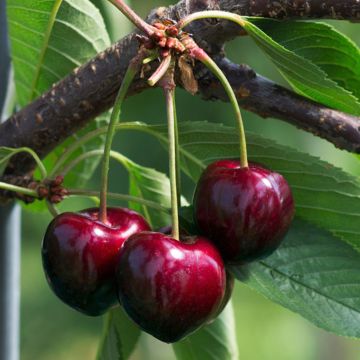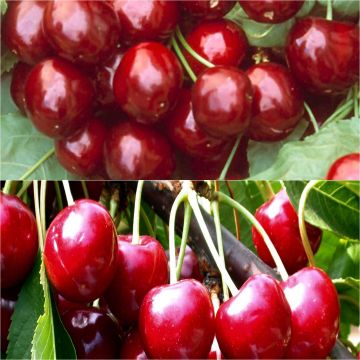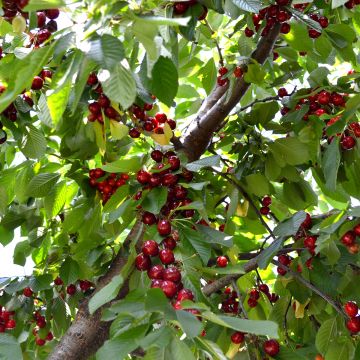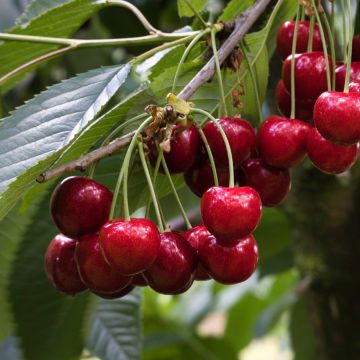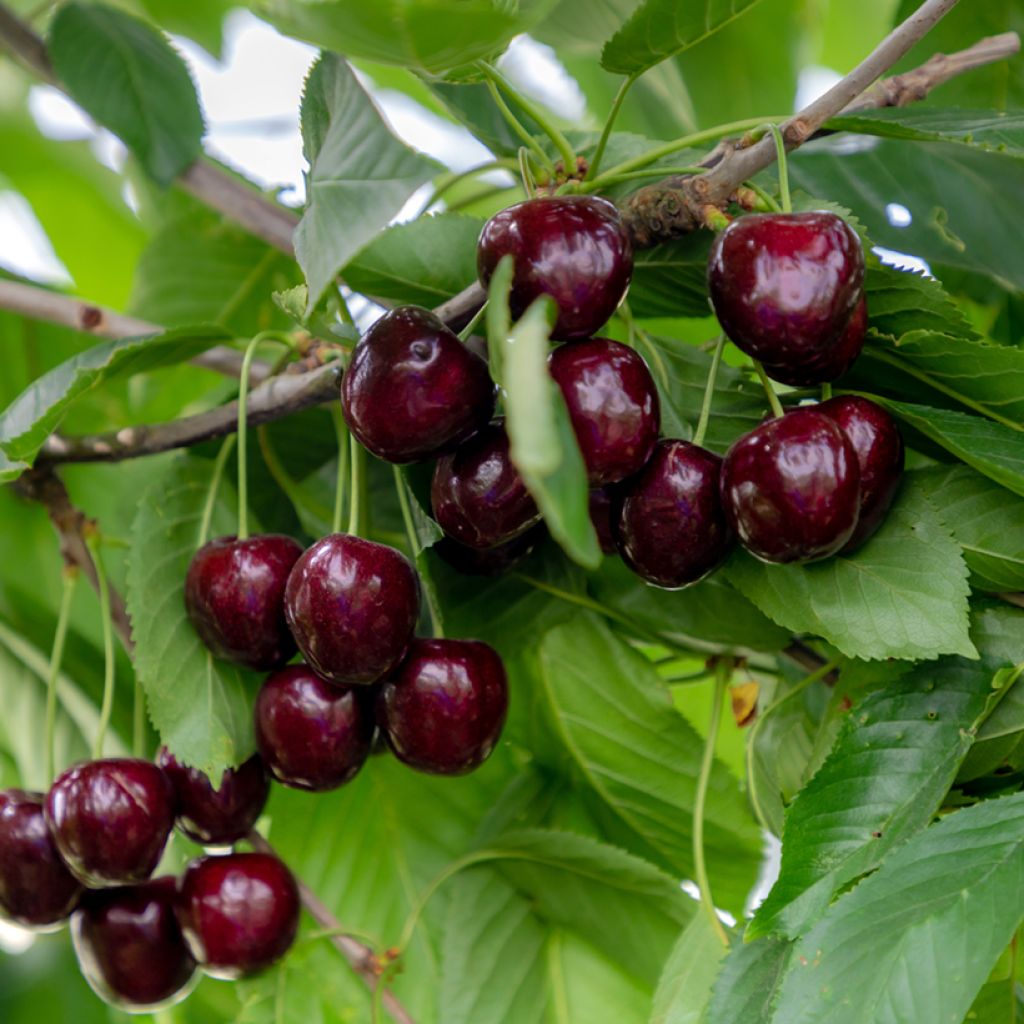

Prunus avium Regina- Cherry Tree
Prunus avium Regina- Cherry Tree
Prunus avium Regina
Wild Cherry, Sweet Cherry
This item cannot be shipped to the selected country
Oversize package delivery charge from €6.90
Delivery to Corse prohibited
More information
Schedule delivery date,
and select date in basket
This plant carries a 6 months recovery warranty
More information
We guarantee the quality of our plants for a full growing cycle, and will replace at our expense any plant that fails to recover under normal climatic and planting conditions.
Oversize package: home delivery by special carrier from €6.90 per order..
Express home delivery from €8.90.
Delivery to Corse prohibited: UE law prohibits the import of this plant from mainland France to Corse as part of the fight against Xylella fastidiosa. Please accept our sincere apologies.
More information
Description
The 'Regina' cherry is a variety of cherry tree from the bigarreau group known for its dark purple-red, sweet, tasty fruits, resistant to splitting and with good keeping quality. Developed in Germany in 1981, this late variety produces sweet and slightly acidic cherries, perfect for fresh consumption. They are harvested in July. With a late flowering in April, this cherry tree is particularly suited to northern and mid-altitude climates.
Prunus avium 'Regina' belongs to the Rosaceae family. This variety originates from Germany. Developed in 1981 at the York Station, it is widely grown in Belgium and Germany. This vigorous fruit tree reaches a height of 4 to 6 m and has a semi-erect habit. It grows rapidly with a fairly quick fruiting for a cherry tree. Its white flowers appear in April, about 5 to 10 days after the variety 'Bigarreau Burlat'. Pollinated by insects, they give rise to heart-shaped, elongated fruits with thick, shiny dark purple skin. The medium to large cherries (24 to 28 mm), weighing 8 to 9.5 grams, are firm, sweet, slightly acidic, and carried by a long stalk. They keep for approximately a week. Their taste quality is good and their flesh is very sweet with very little acidity. They are moderately juicy, even poor in juice in hot conditions. Fruit firmness and keeping quality are disappointing in high temperatures.
This 'Regina' cherry tree is said to be self-sterile or self-incompatible, as the flowers cannot self-pollinate. Hence, the presence of other cherry tree varieties nearby, flowering at the same time, is necessary. For instance, the varieties Summit and 'Noir de Meched'.
Prunus avium belongs to the Rosaceae family, like the Sour Cherry Tree (Prunus cerasus). Also known as Wild Cherry or Bird Cherry, it originates from Europe, Western Asia, and North Africa, and has been present in Europe since the Neolithic period (polished stone age).
The 'Regina' cherry harvest starts around late June and extends into July, about 30 to 35 days after the 'Burlat' cherries. It is important to pick the fruits when ripe, as they do not ripen further, and with their stems to ensure good preservation. Due to their fragility, cherries should be carefully harvested with a picking pole or manually on a ladder. This very sweet cherry is delicious when eaten fresh. In cooking, it reveals all its flavours in clafoutis, cakes, crumbles or pies, fruit salads, and as an accompaniment to savoury dishes with white meats (turkey, chicken, veal, duck...). Perfect also for making jams, fruit in syrup, or preserves.
With its content of vitamins A, C and E, phenolic antioxidants, calcium and copper, with a significant iron intake, its richness in trace elements and fibres, cherries are a healthy choice. The fruits only keep for a few days in a cool place or in the refrigerator. They can also be frozen once washed, dried, stemmed, and pitted.
The cherry tree is very popular and finds a place in the garden, planted on a lawn, in an orchard, or within a large fruit hedge. Among our wide range of cherry trees, it is easy to find the variety that best suits one's desires.
Report an error about the product description
Plant habit
Fruit
Flowering
Foliage
Botanical data
Prunus
avium
Regina
Rosaceae
Wild Cherry, Sweet Cherry
Cultivar or hybrid
Other Cherry trees
Planting and care
The 'Regina' Bigarreau Cherry Tree grows in any type of soil, whether acidic or calcareous. It appreciates moist, light soils and dislikes soils that are too heavy and clayey. Choose a sunny location. To limit the risks of late frosts on the flowers, plant the Cherry Tree in a sheltered position, facing west and protected from cold winds in regions that experience spring frosts. Plant in autumn or alternatively in winter, avoiding frost periods. If you plant several trees, space them 7 to 10 m apart for "standard" cherry trees, 5 to 7 m apart for "half-standard" cherry trees, and 4 to 5 m apart for bush and spindle trees
Loosen the soil deeply and remove stones and unwanted weeds. Add some sand to improve drainage. Dig a hole 4 to 5 times the size of the root ball. Make sure to separate the subsoil from the topsoil. Mix crushed horn or well-rotted compost or potting soil with the suboil and pour this mixture into the planting hole. Install a stake. Place the root ball, cover with the topsoil and tamp down well. Water generously (about 10 litres). Position your attachment system, crossing it in a figure of 8 so that the trunk and the stake do not rub against each other.
The cherry tree can be prone to various diseases and pests. Against grey rot (velvety rot on fruits) and brown rot (drying of flowers and fruit rot on the tree), remove and burn the affected parts curatively and, preventively, spray Bordeaux mixture or horsetail or garlic decoctions in early spring and autumn. Against bacterial canker (drying of floral clusters, brown spots, bark deformation), spray Bordeaux mixture. As for pests, the cherry fruit fly or fruit worm can be countered preventively by installing yellow cardboard discs covered with glue, pheromone traps (trapping male insects), or a Drosophila trap, easy to make from a plastic bottle, in spring. In case of attack by black aphids, spray a mixture of water and black soap or water and vegetable oil.
Planting period
Intended location
Care
This item has not been reviewed yet - be the first to leave a review about it.
Haven't found what you were looking for?
Hardiness is the lowest winter temperature a plant can endure without suffering serious damage or even dying. However, hardiness is affected by location (a sheltered area, such as a patio), protection (winter cover) and soil type (hardiness is improved by well-drained soil).

Photo Sharing Terms & Conditions
In order to encourage gardeners to interact and share their experiences, Promesse de fleurs offers various media enabling content to be uploaded onto its Site - in particular via the ‘Photo sharing’ module.
The User agrees to refrain from:
- Posting any content that is illegal, prejudicial, insulting, racist, inciteful to hatred, revisionist, contrary to public decency, that infringes on privacy or on the privacy rights of third parties, in particular the publicity rights of persons and goods, intellectual property rights, or the right to privacy.
- Submitting content on behalf of a third party;
- Impersonate the identity of a third party and/or publish any personal information about a third party;
In general, the User undertakes to refrain from any unethical behaviour.
All Content (in particular text, comments, files, images, photos, videos, creative works, etc.), which may be subject to property or intellectual property rights, image or other private rights, shall remain the property of the User, subject to the limited rights granted by the terms of the licence granted by Promesse de fleurs as stated below. Users are at liberty to publish or not to publish such Content on the Site, notably via the ‘Photo Sharing’ facility, and accept that this Content shall be made public and freely accessible, notably on the Internet.
Users further acknowledge, undertake to have ,and guarantee that they hold all necessary rights and permissions to publish such material on the Site, in particular with regard to the legislation in force pertaining to any privacy, property, intellectual property, image, or contractual rights, or rights of any other nature. By publishing such Content on the Site, Users acknowledge accepting full liability as publishers of the Content within the meaning of the law, and grant Promesse de fleurs, free of charge, an inclusive, worldwide licence for the said Content for the entire duration of its publication, including all reproduction, representation, up/downloading, displaying, performing, transmission, and storage rights.
Users also grant permission for their name to be linked to the Content and accept that this link may not always be made available.
By engaging in posting material, Users consent to their Content becoming automatically accessible on the Internet, in particular on other sites and/or blogs and/or web pages of the Promesse de fleurs site, including in particular social pages and the Promesse de fleurs catalogue.
Users may secure the removal of entrusted content free of charge by issuing a simple request via our contact form.
The flowering period indicated on our website applies to countries and regions located in USDA zone 8 (France, the United Kingdom, Ireland, the Netherlands, etc.)
It will vary according to where you live:
- In zones 9 to 10 (Italy, Spain, Greece, etc.), flowering will occur about 2 to 4 weeks earlier.
- In zones 6 to 7 (Germany, Poland, Slovenia, and lower mountainous regions), flowering will be delayed by 2 to 3 weeks.
- In zone 5 (Central Europe, Scandinavia), blooming will be delayed by 3 to 5 weeks.
In temperate climates, pruning of spring-flowering shrubs (forsythia, spireas, etc.) should be done just after flowering.
Pruning of summer-flowering shrubs (Indian Lilac, Perovskia, etc.) can be done in winter or spring.
In cold regions as well as with frost-sensitive plants, avoid pruning too early when severe frosts may still occur.
The planting period indicated on our website applies to countries and regions located in USDA zone 8 (France, United Kingdom, Ireland, Netherlands).
It will vary according to where you live:
- In Mediterranean zones (Marseille, Madrid, Milan, etc.), autumn and winter are the best planting periods.
- In continental zones (Strasbourg, Munich, Vienna, etc.), delay planting by 2 to 3 weeks in spring and bring it forward by 2 to 4 weeks in autumn.
- In mountainous regions (the Alps, Pyrenees, Carpathians, etc.), it is best to plant in late spring (May-June) or late summer (August-September).
The harvesting period indicated on our website applies to countries and regions in USDA zone 8 (France, England, Ireland, the Netherlands).
In colder areas (Scandinavia, Poland, Austria...) fruit and vegetable harvests are likely to be delayed by 3-4 weeks.
In warmer areas (Italy, Spain, Greece, etc.), harvesting will probably take place earlier, depending on weather conditions.
The sowing periods indicated on our website apply to countries and regions within USDA Zone 8 (France, UK, Ireland, Netherlands).
In colder areas (Scandinavia, Poland, Austria...), delay any outdoor sowing by 3-4 weeks, or sow under glass.
In warmer climes (Italy, Spain, Greece, etc.), bring outdoor sowing forward by a few weeks.

































